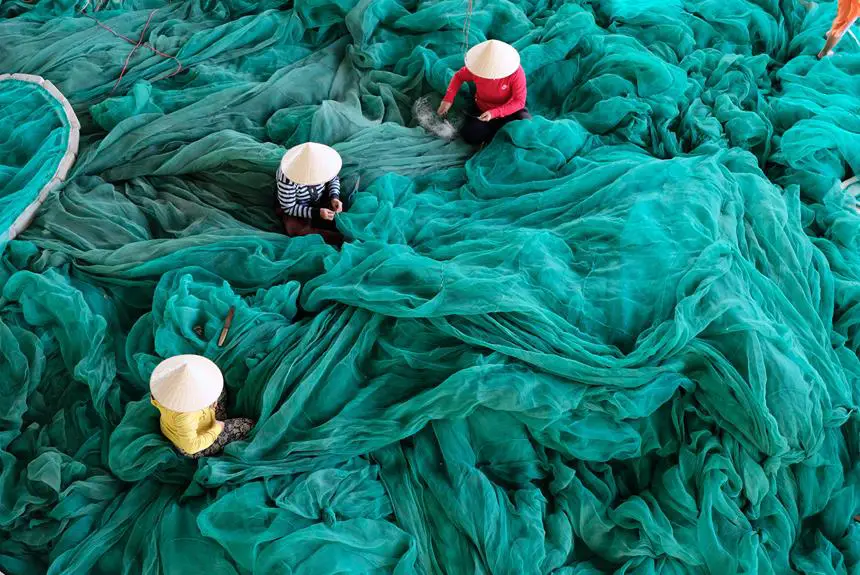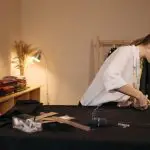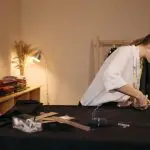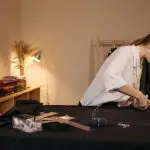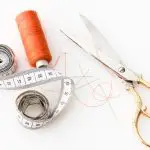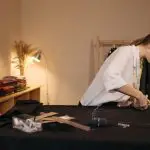You might think that any old pair of scissors will do for your sewing projects, but when it comes to working with fabric, having the right type of fabric scissors can make all the difference.
From tailoring scissors to pinking shears, there are a variety of options to choose from, each designed for specific tasks. Understanding the differences between them and knowing which ones are best for your particular sewing projects can elevate the quality of your work.
In this guide, we'll explore the various types of fabric scissors and help you determine which one is best suited to your needs.
So, let's dive in and find the perfect pair of fabric scissors for your next sewing endeavor.
Key Takeaways
- All-purpose fabric scissors are versatile and can handle a wide range of fabrics.
- Precision fabric scissors are designed for intricate cuts on delicate fabrics.
- Heavy-duty fabric scissors are essential for cutting heavier fabrics like denim or upholstery material.
- Prioritize comfort and handle design to minimize hand fatigue.
Types of Fabric Scissors
You should consider using a high-quality pair of fabric scissors for your sewing projects to ensure clean and precise cuts. When it comes to fabric cutting, having the right tools can make all the difference.
There are various scissor types designed specifically for different fabric cutting needs. For general fabric cutting, all-purpose fabric scissors are a great choice. They're versatile and can handle a wide range of fabrics with ease.
If you work with delicate or intricate fabrics, consider investing in a pair of precision fabric scissors. These are designed to make intricate cuts with precision, ensuring that your delicate fabrics remain undamaged.
For heavier fabrics like denim or upholstery material, heavy-duty fabric scissors are essential. They've a more robust build and sharp blades that can power through tougher materials.
Understanding the different scissor types and their specific uses can greatly improve the quality of your fabric cutting and ultimately enhance the overall outcome of your sewing projects.
Considerations for Sewing Scissors
When selecting sewing scissors, prioritize comfort and handle design to ensure ease of use and minimize hand fatigue. An ergonomic handle design is crucial for reducing strain on your hands and fingers during extended cutting sessions. Look for scissors with handles that fit comfortably in your hand and provide a good grip to prevent slipping.
Additionally, blade sharpness is a key consideration. Sharp blades ensure clean, precise cuts and reduce the effort required to cut through fabrics, ultimately minimizing hand strain. When testing scissors, pay attention to how easily the blades cut through different types of fabric. You want a pair that effortlessly glides through various materials without requiring excessive force.
Tailoring Scissors Vs. Dressmaking Shears
To determine the best fabric scissors for your sewing projects, consider the differences between tailoring scissors and dressmaking shears. Tailoring scissors and dressmaking shears are both essential tools in garment construction, but they serve different purposes and have distinct cutting techniques. Here's what you need to know:
- Tailoring Scissors: Tailoring scissors are heavy-duty scissors designed for cutting through multiple layers of fabric and for tasks such as cutting out pattern pieces, notching, and grading seams. They're usually longer and have one smaller finger hole to provide better leverage and control.
- Dressmaking Shears: Dressmaking shears are versatile scissors ideal for cutting fabric in garment construction. They're designed to cut smoothly through various types of fabric, making them suitable for tasks such as cutting out pattern pieces, trimming seams, and shaping fabric. Dressmaking shears typically have longer blades and two identically sized finger holes for comfortable handling.
- Cutting Techniques: Tailoring scissors are adept at making long, straight cuts, while dressmaking shears excel at intricate and curved cuts, enhancing precision in dressmaking and tailoring projects.
- Choosing the Right Tool: Consider the specific cutting techniques and tasks required for your sewing projects to determine whether tailoring scissors or dressmaking shears are the best fit.
Pinking Shears for Fabric Finishing
Pinking shears are a must-have tool for finishing fabric edges with a zigzag pattern. They create a neat and decorative edge that helps prevent fraying, making them ideal for seam finishing and crafts like quilting.
When choosing pinking shears, look for sharp, durable blades that will give you clean and precise cuts every time.
Pinking Shears for Zigzag
You need a good pair of pinking shears to create a zigzag edge on your fabric for a professional-looking finish. Pinking shears are specifically designed with sawtooth blades to prevent fabric fraying and unraveling. When it comes to fabric finishing, pinking shears are a versatile tool to have in your sewing kit. Here's why they're essential:
- Prevent Fraying: Pinking shears create a zigzag edge that helps prevent fraying, making them ideal for finishing seams on lightweight fabrics.
- Decorative Edges: They can be used to add decorative edges to fabric, giving your projects a unique and professional touch.
- Cost-Effective Alternative: Pinking shears offer a cost-effective alternative to serging or overlocking machines, especially for those who are just starting out in sewing.
- Versatile Use: Apart from fabric, pinking shears can also be used on paper and other crafting materials for decorative purposes.
Fabric Edges With Pinking
For achieving clean and fray-resistant fabric edges, consider using pinking shears as a versatile tool in your sewing projects.
Pinking shears are designed with sawtooth blades that create a zigzag cutting pattern along the fabric edge. This unique cutting action helps prevent fraying by minimizing the length of the fabric threads that are exposed.
When you use pinking shears, you're not only finishing the fabric edges in a functional way but also adding decorative finishes to your projects. This makes them ideal for seam finishes on lightweight fabrics, reducing bulk while adding a decorative touch.
Pinking shears are a great addition to your sewing toolkit, especially when you want to achieve both functionality and aesthetic appeal in your fabric edges.
Understanding Embroidery Scissors
When it comes to embroidery scissors, it's important to consider the size and precision of the blades, as this will impact the intricacy of your stitching.
There are various types of embroidery scissors designed for different stitching techniques, so understanding these types can help you choose the right tool for your projects.
Quality and durability are also key factors to keep in mind when selecting embroidery scissors, ensuring they remain reliable and effective over time.
Size and Precision
Choosing the right size and precision of embroidery scissors can significantly improve the quality of your sewing projects. When it comes to embroidery scissors, size and precision are essential factors to consider. Here's what you need to know:
- Size Matters: Opt for smaller scissors, around 3-4 inches, to navigate tight spaces and make intricate cuts with ease.
- Precision Cutting: Look for scissors with fine, pointed tips to ensure precision cutting, especially for delicate embroidery work.
- Comfortable Grip: Check for scissors with comfortable handles that allow for extended use without causing strain.
- Quality Materials: Invest in high-quality stainless steel scissors to ensure durability and long-lasting sharpness.
Types for Embroidery
To understand embroidery scissors, it's important to consider the specific types available and how each one can enhance your sewing experience.
When it comes to embroidery techniques, having the right scissors can make a significant difference. For intricate embroidery work, precision is key, so having a pair of small, sharp-pointed embroidery scissors can help you achieve detailed cuts. These scissors are designed to trim threads close to the fabric without damaging the surrounding stitches.
Additionally, curved embroidery scissors are perfect for reaching tight spaces and trimming threads with ease.
Understanding the different types of embroidery scissors and their specific uses can greatly improve your fabric cutting techniques, making your embroidery projects more enjoyable and precise.
Quality and Durability
Understanding the quality and durability of embroidery scissors will enhance your sewing experience, ensuring precise and long-lasting performance for your intricate embroidery projects. Without the right quality and durability, your embroidery scissors may not provide the precision and reliability needed for achieving detailed cuts and maintaining the integrity of your stitches.
When considering the quality and durability of embroidery scissors, pay attention to the following:
- Blade Material: Opt for high-quality stainless steel or titanium-coated blades for sharpness and corrosion resistance.
- Comfort: Look for scissors with ergonomic handles to reduce hand fatigue during prolonged use.
- Longevity: Choose scissors with a solid construction that can withstand repeated use without losing sharpness.
- Performance: Select scissors with fine tips for intricate cutting and precise detailing.
Specialty Scissors for Quilting
You'll want to consider investing in specialty quilting scissors for more precise cutting when working on your quilting projects. Quilting demands accuracy and attention to detail, and having the right tools can make all the difference.
Specialty quilting scissors are designed to handle the specific needs of quilters, whether you're working on intricate quilting techniques or cutting through multiple layers of fabric. These scissors often have a longer blade, which allows for smooth and precise cutting, especially when dealing with large quilting fabric selections. Additionally, they've a comfortable handle that provides a good grip, reducing hand fatigue during extended cutting sessions.
When working with different quilting patterns, these scissors can easily maneuver around curves and tight corners, making them an essential tool for quilters. Look for scissors with serrated edges to prevent fabric from slipping while cutting, ensuring clean and accurate lines.
Investing in specialty quilting scissors won't only enhance the quality of your work but also make the quilting process more enjoyable and efficient.
Ergonomic Features in Fabric Scissors
When selecting fabric scissors, it's essential to regularly consider the ergonomic features to ensure comfortable and efficient cutting. Ergonomic design plays a crucial role in reducing hand fatigue and ensuring that you can work on your sewing projects for longer periods without discomfort.
Here are some key ergonomic features to look for in fabric scissors:
- Handle Shape: Look for scissors with handles that fit comfortably in your hand and allow for a natural grip. Ergonomically designed handles can help reduce strain on your fingers and wrist.
- Weight Distribution: Consider scissors that have a balanced weight distribution. This helps prevent hand fatigue during extended use, as it reduces the effort required to open and close the blades.
- Soft Grip Handles: Opt for fabric scissors with soft grip handles, as they provide extra comfort and reduce the pressure on your hands, especially when working on intricate or lengthy cutting tasks.
- Adjustable Tension Screw: Some fabric scissors come with an adjustable tension screw, allowing you to customize the cutting tension to suit your hand strength and cutting style, further reducing hand fatigue.
Care and Maintenance Tips
To maintain the sharpness and longevity of your fabric scissors, regularly clean any lint or debris from the blades using a soft cloth.
Proper maintenance is crucial for ensuring that your fabric scissors remain in top condition. When not in use, store your scissors in a dry place to prevent rusting.
Additionally, it's essential to sharpen your fabric scissors regularly to maintain their cutting efficiency. Proper hand positioning and cutting technique also play a significant role in the maintenance of your fabric scissors. Ensure that you're using the correct grip and cutting angle to prevent unnecessary strain on the blades.
When cutting, avoid materials that can dull the blades quickly, such as paper or cardboard.
Frequently Asked Questions
Can Regular Household Scissors Be Used for Sewing Projects in a Pinch?
In a pinch, you can use household scissors for emergency sewing. However, regular scissors may not produce clean, accurate cuts, affecting the quality of your sewing projects. It's best to invest in fabric scissors for precise cuts.
What Are the Best Scissors for Cutting Delicate Fabrics Like Silk or Chiffon?
When cutting delicate fabrics like silk or chiffon, the best scissors for the job are those with sharp blades and an ergonomic design for a comfortable grip. Remember to maintain and sharpen them regularly.
Are There Any Specific Scissors Recommended for Cutting Through Multiple Layers of Fabric?
For cutting through multiple layers of fabric, fabric shears or pinking shears are ideal. They provide clean, precise cuts. If you're dealing with intricate patterns, rotary cutters or electric scissors can also make the task easier.
Can Left-Handed Individuals Use the Same Types of Fabric Scissors as Right-Handed Individuals, or Are There Specific Options for Them?
Left-handed options for fabric scissors include ergonomic designs and specialized grips. These cater to your needs, ensuring comfort and precision. Consider tailor or sewing scissors, and explore pinking shears or rotary cutters for versatility.
Is It Necessary to Invest in Expensive Fabric Scissors, or Are There More Affordable Options That Still Work Well for Sewing Projects?
You don't have to splurge on expensive fabric scissors. Budget options can still deliver excellent performance, and you'll find that they work well for various sewing projects. It's worth considering a performance comparison before making your choice.
- Why Do My Linen Clothes Sometimes Develop Pills? - June 11, 2025
- How to Remove Pilling From Chenille Fabric Without Snagging It? - June 11, 2025
- What’s the Best Way to Store Clothes to Minimize Pilling Risks? - June 11, 2025

